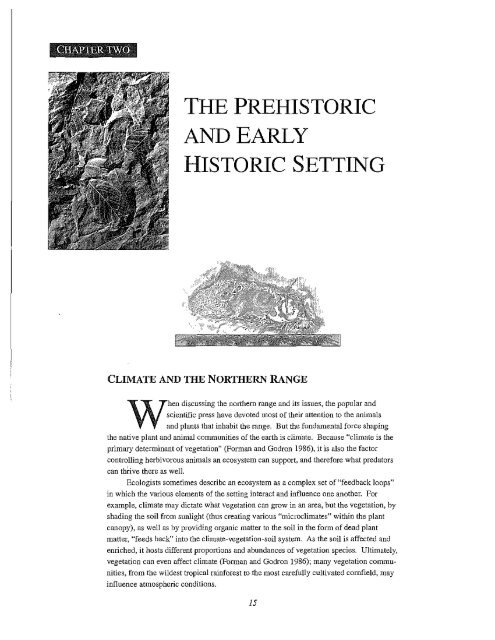Yellowstone's Northern Range - Greater Yellowstone Science ...
Yellowstone's Northern Range - Greater Yellowstone Science ...
Yellowstone's Northern Range - Greater Yellowstone Science ...
Create successful ePaper yourself
Turn your PDF publications into a flip-book with our unique Google optimized e-Paper software.
THE PREHISTORIC<br />
AND EARLY<br />
HISTORIC SETTING<br />
CLIMATE AND THE NORTHERN RANGE<br />
When discussing the northern range and its issues, the popular and<br />
scientific press have devoted most of their attention to the animals<br />
and plants that inhabit the range. But the fundamental force shaping<br />
the native plant and animal communities of the earth is climate. Because "climate is the<br />
primary deternrinant of vegetation" (Forman and Godron 1986), it is also the factor<br />
controlling herbivorous animals an ecosystem can support, and therefore what predators<br />
can thflve there as well.<br />
Ecologists sometimes describe an ecosystem as a complex set of "feedback loops"<br />
in which the various elements of the setting interact and influence one another. For<br />
example, climate may dictate what vegetation can grow in an area, but the vegetation, by<br />
shading the soil from sunlig.ht (thus creating various "microclimates" within the plant<br />
canopy), as well as by providing organic malter to the soil in the fonm of dead plant<br />
malter, "feeds back" into the cJimate-vegetation-soil system. As the soil is affected and<br />
enriched, it hosts different proportions and abundances of vegetation species. Ultimately,<br />
vegetation can even affect climate (Forman and Godron 1986); many vegetation communities,<br />
from the wildest tropical rainforest to the most carefully cultivated cornfield, may<br />
influence atmospheric conditions.<br />
15















